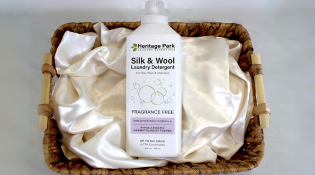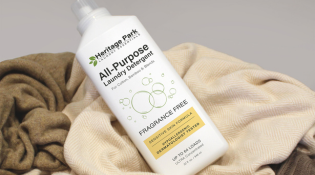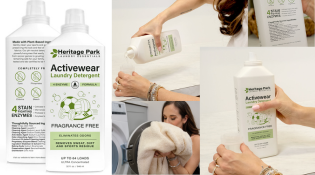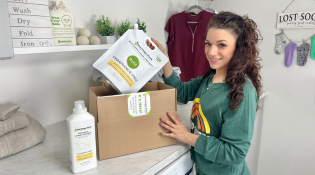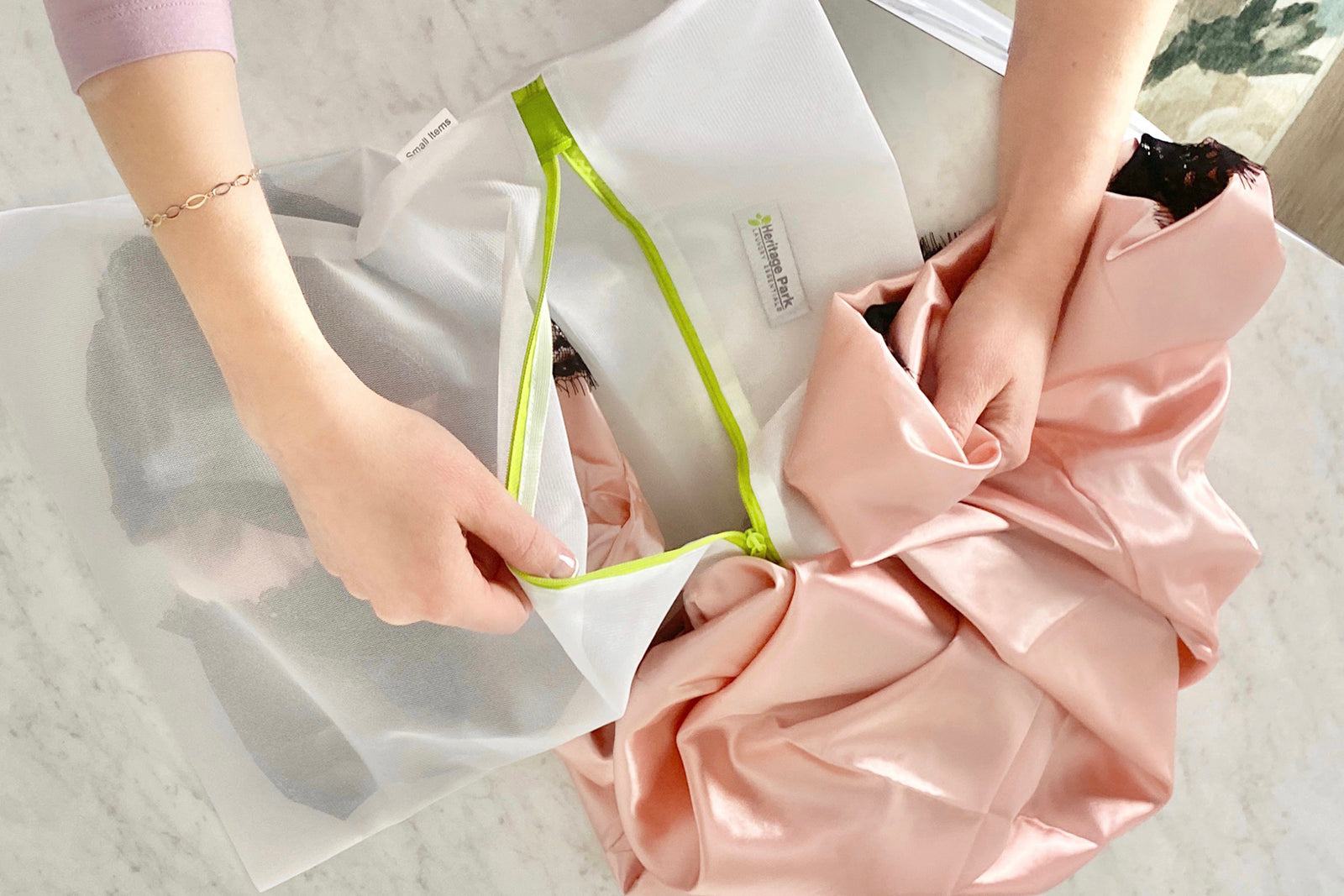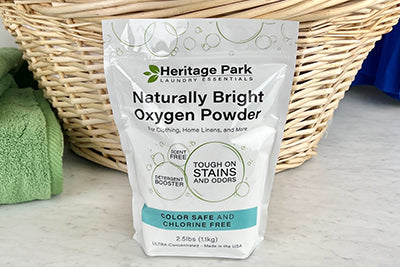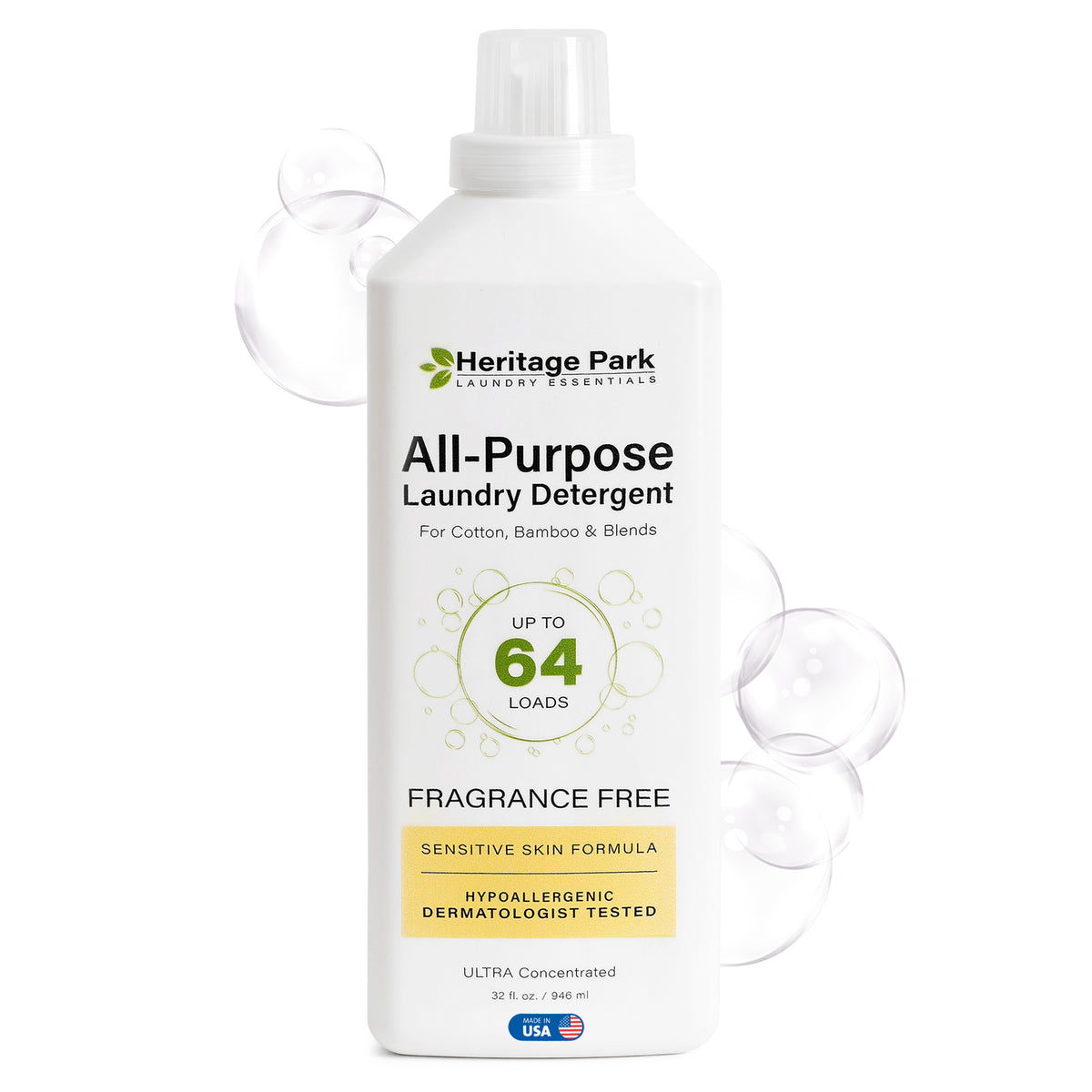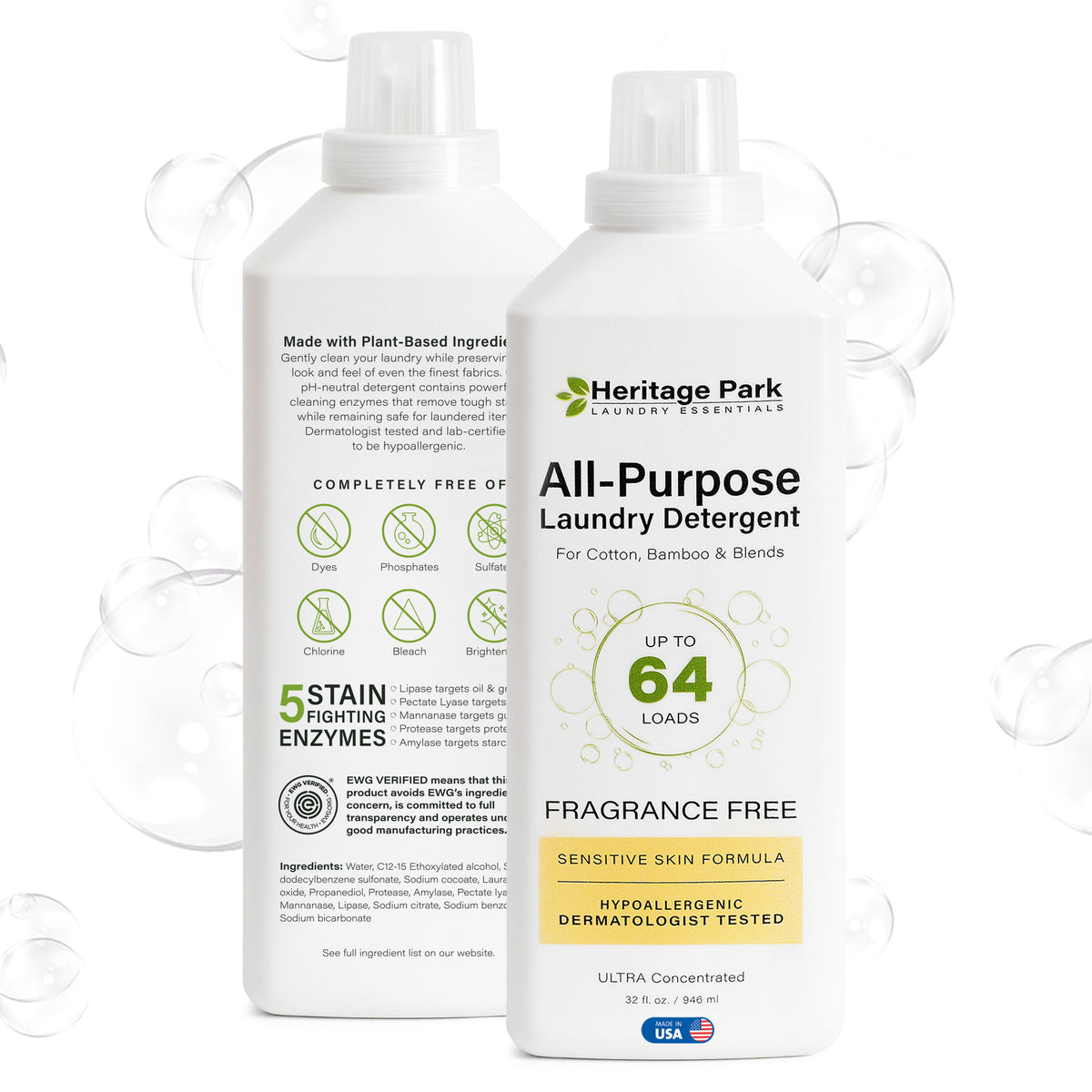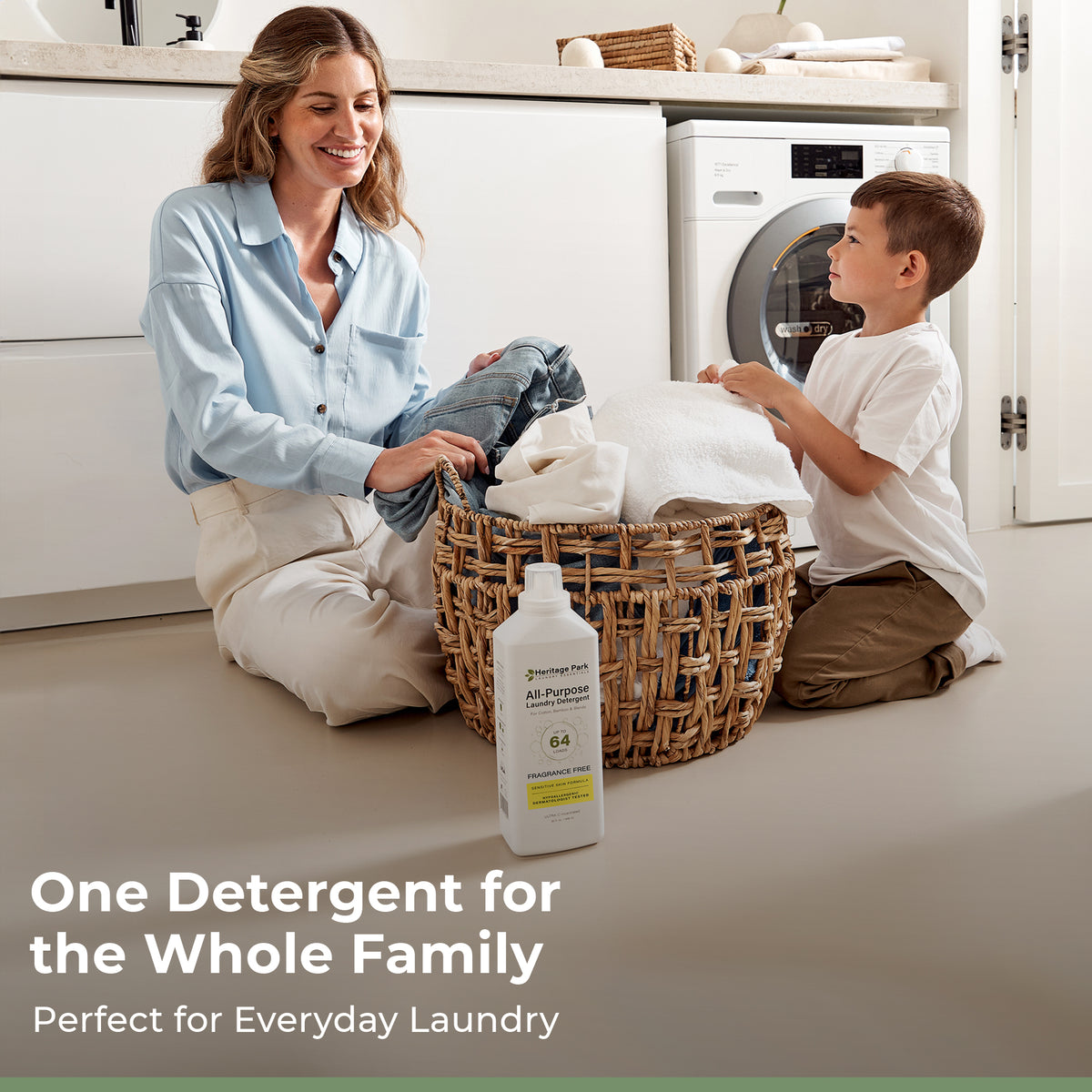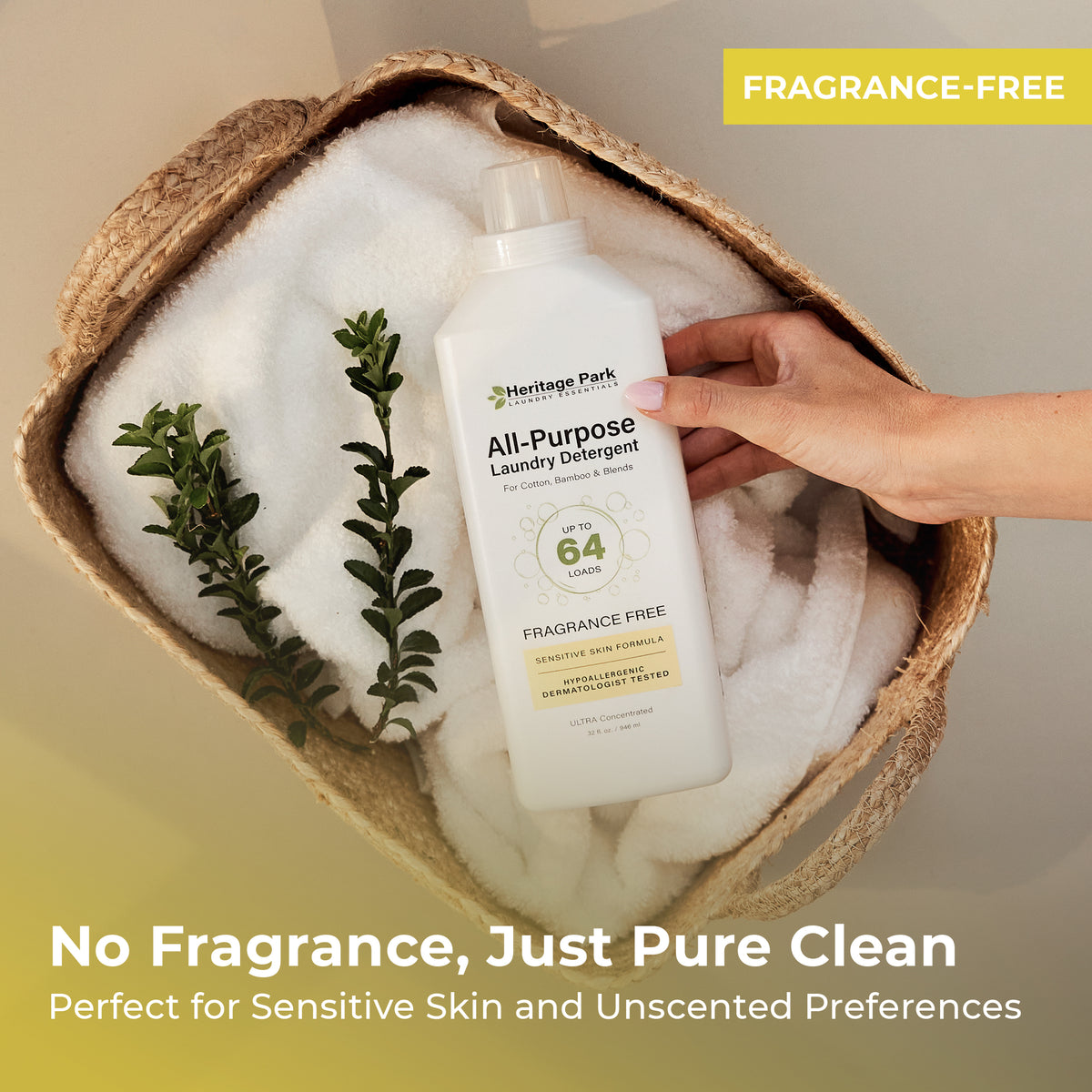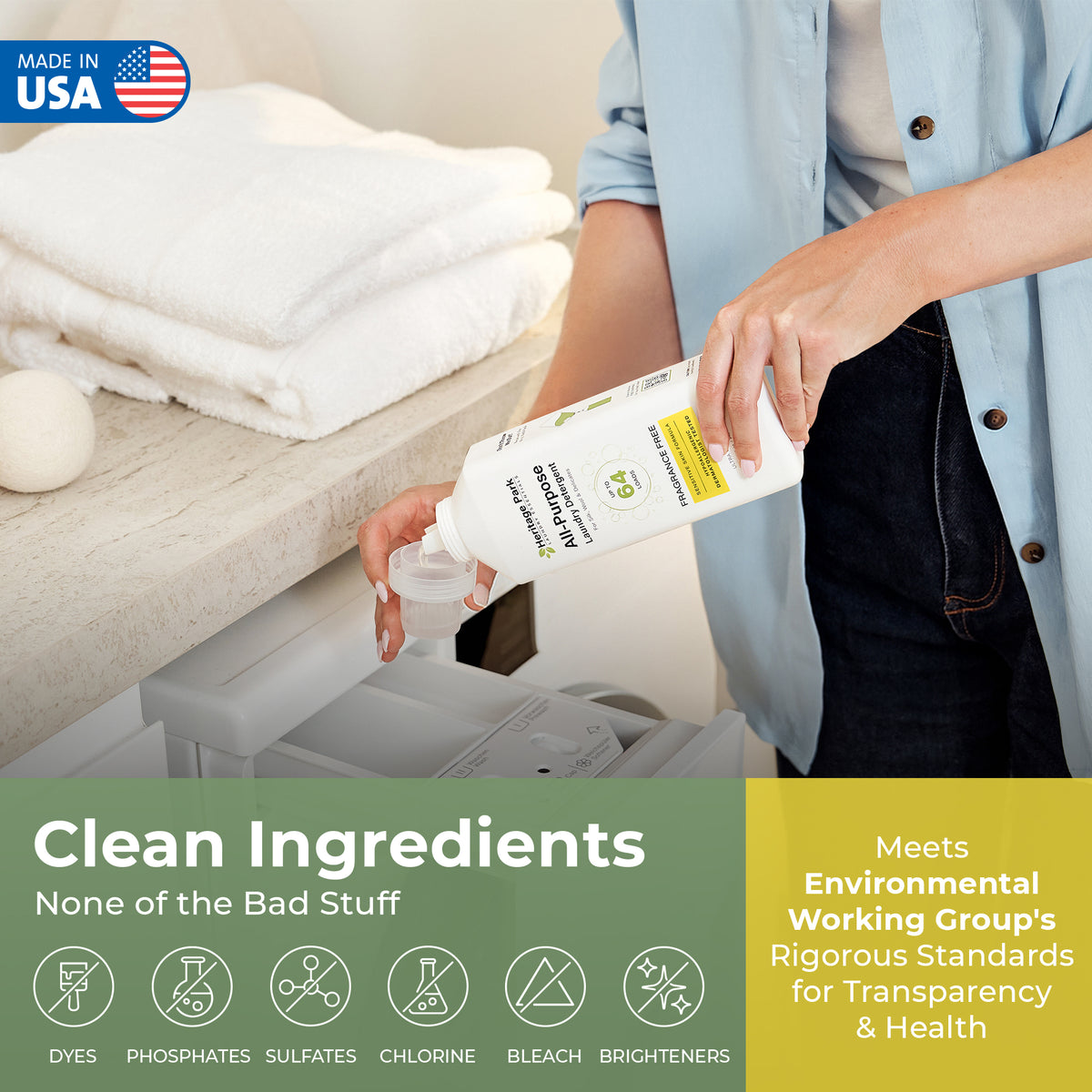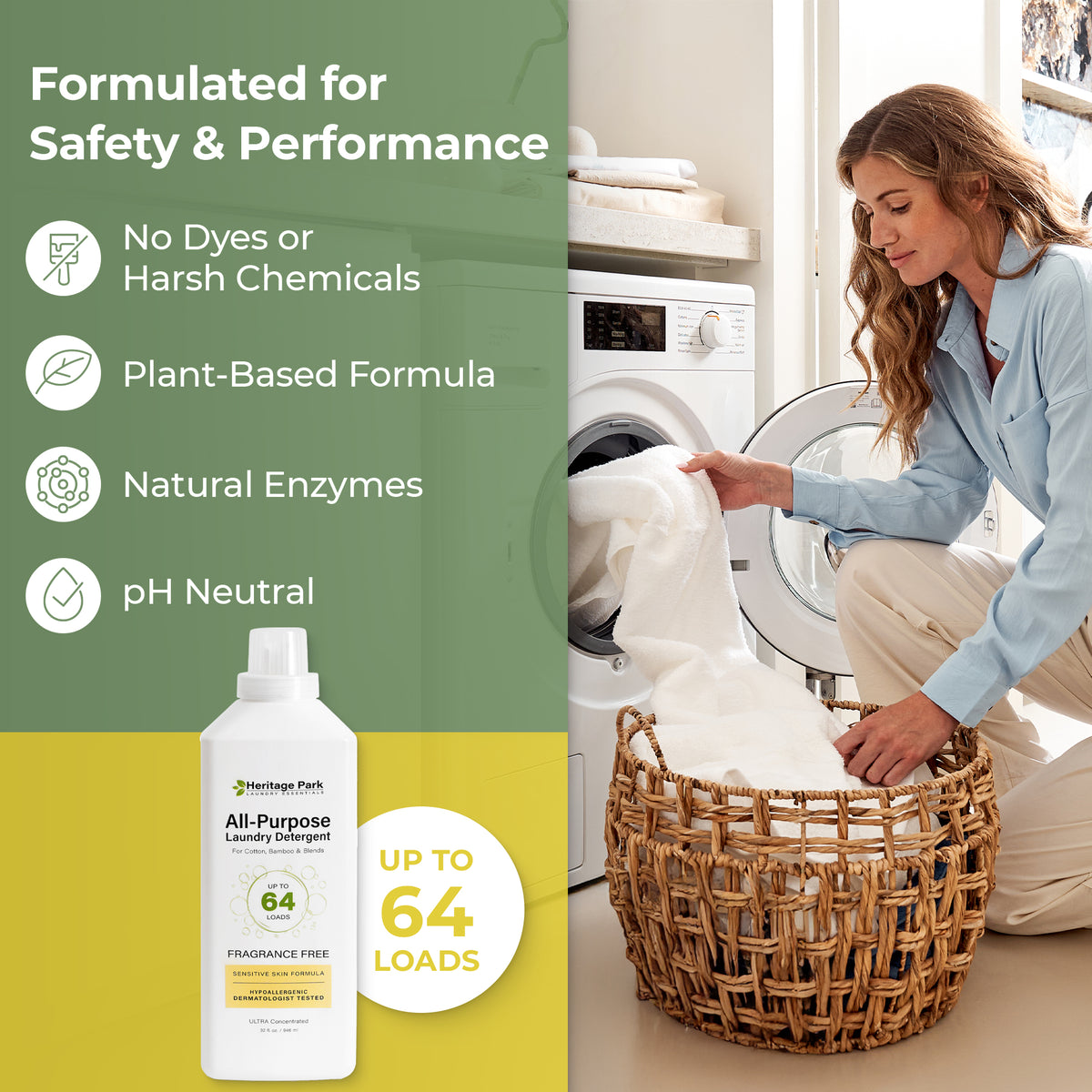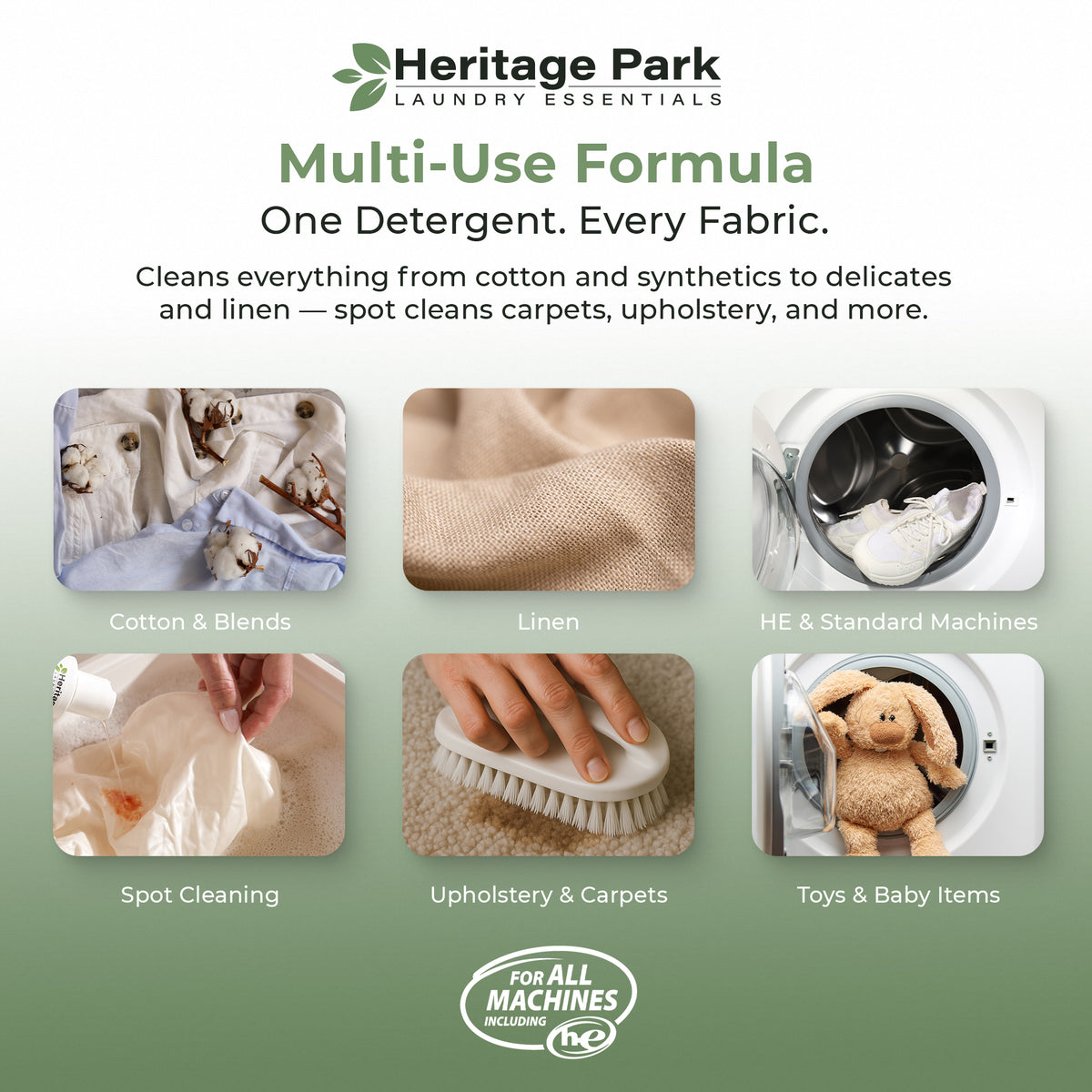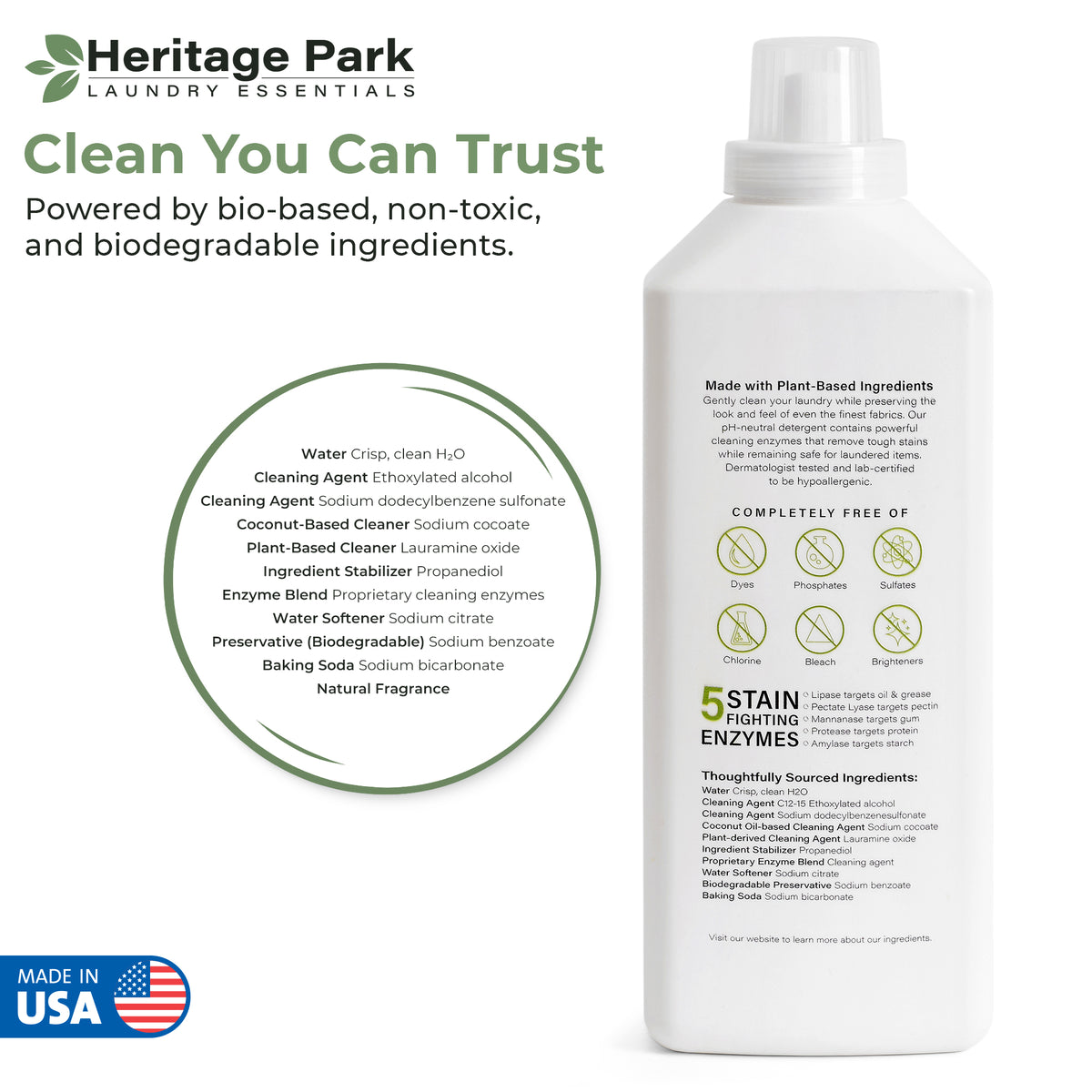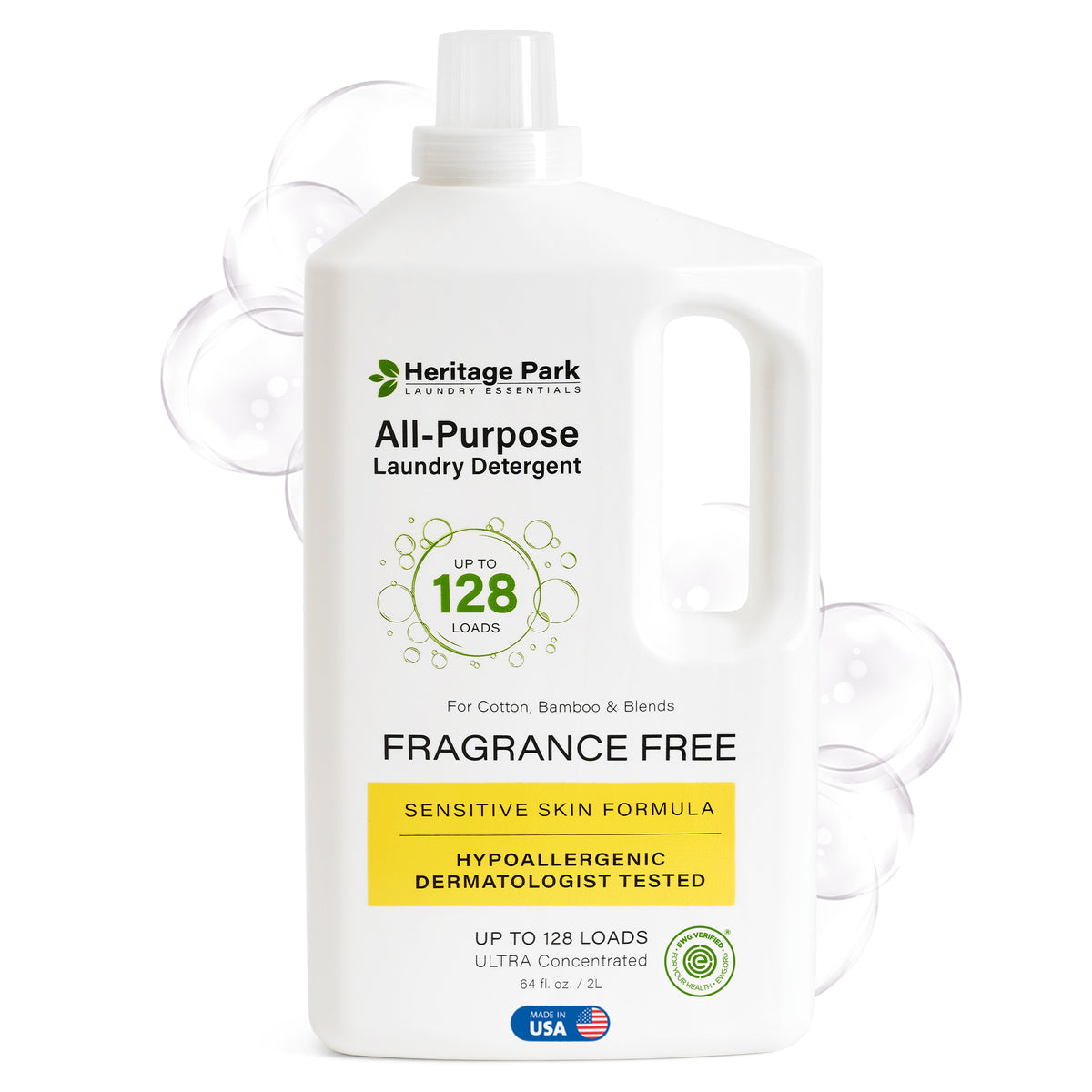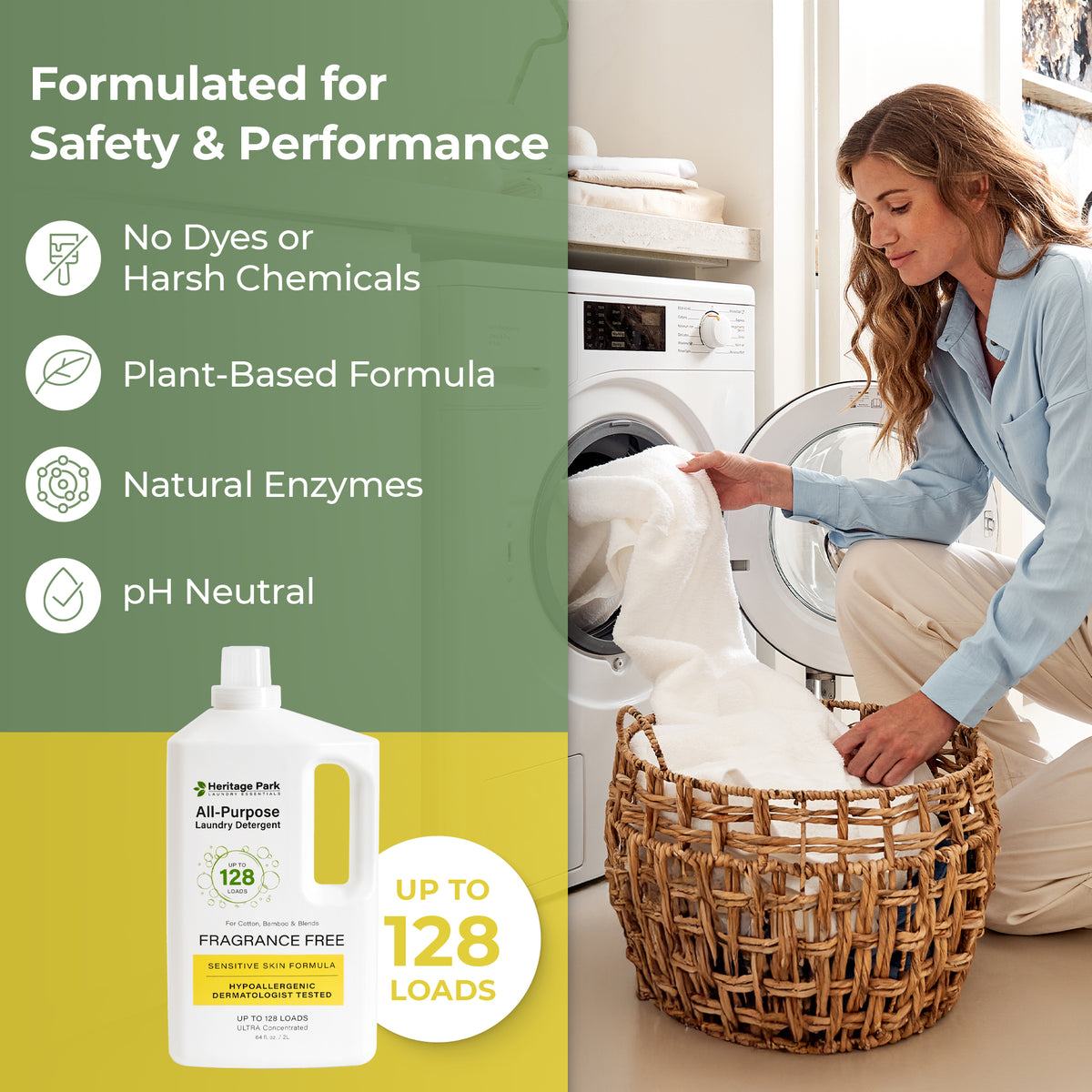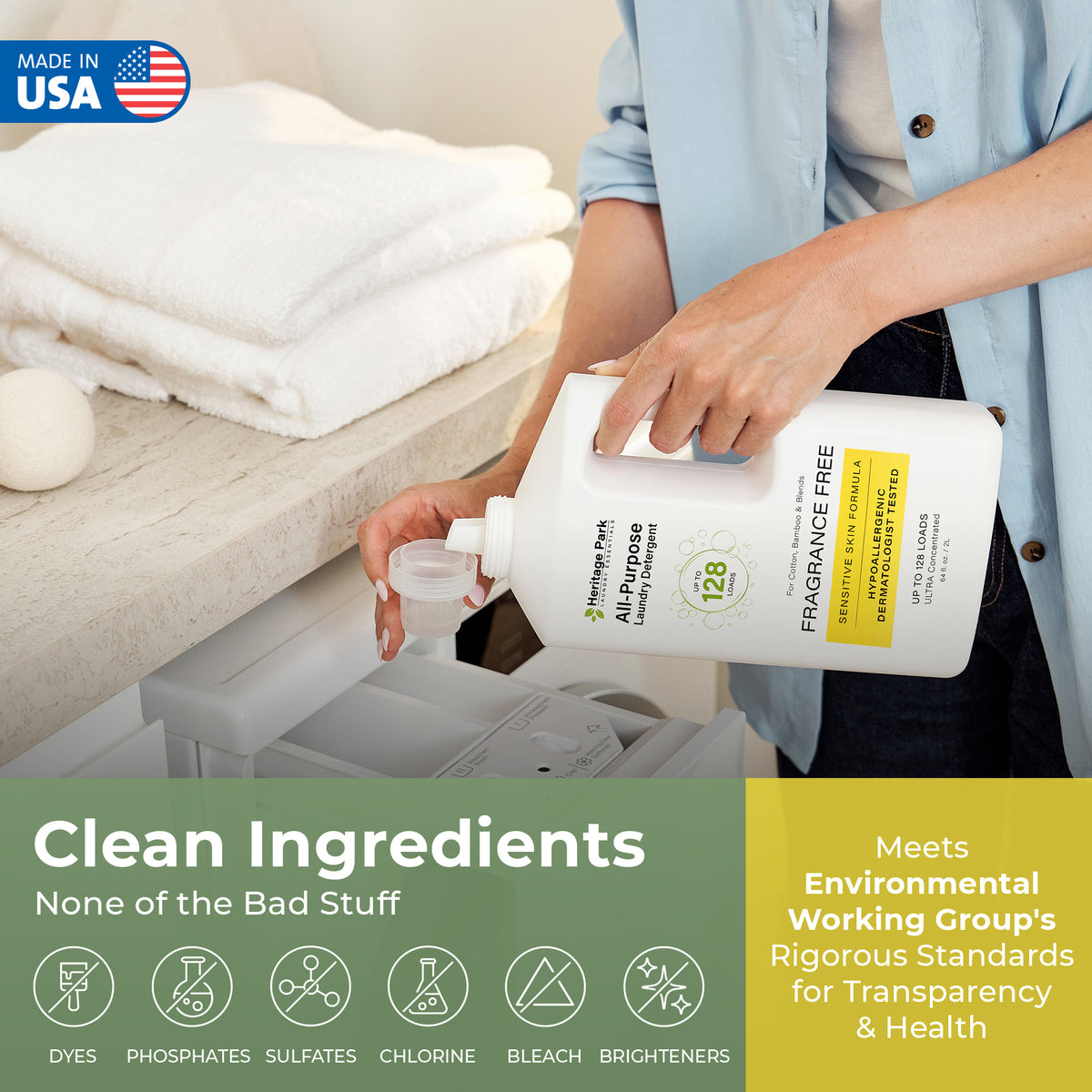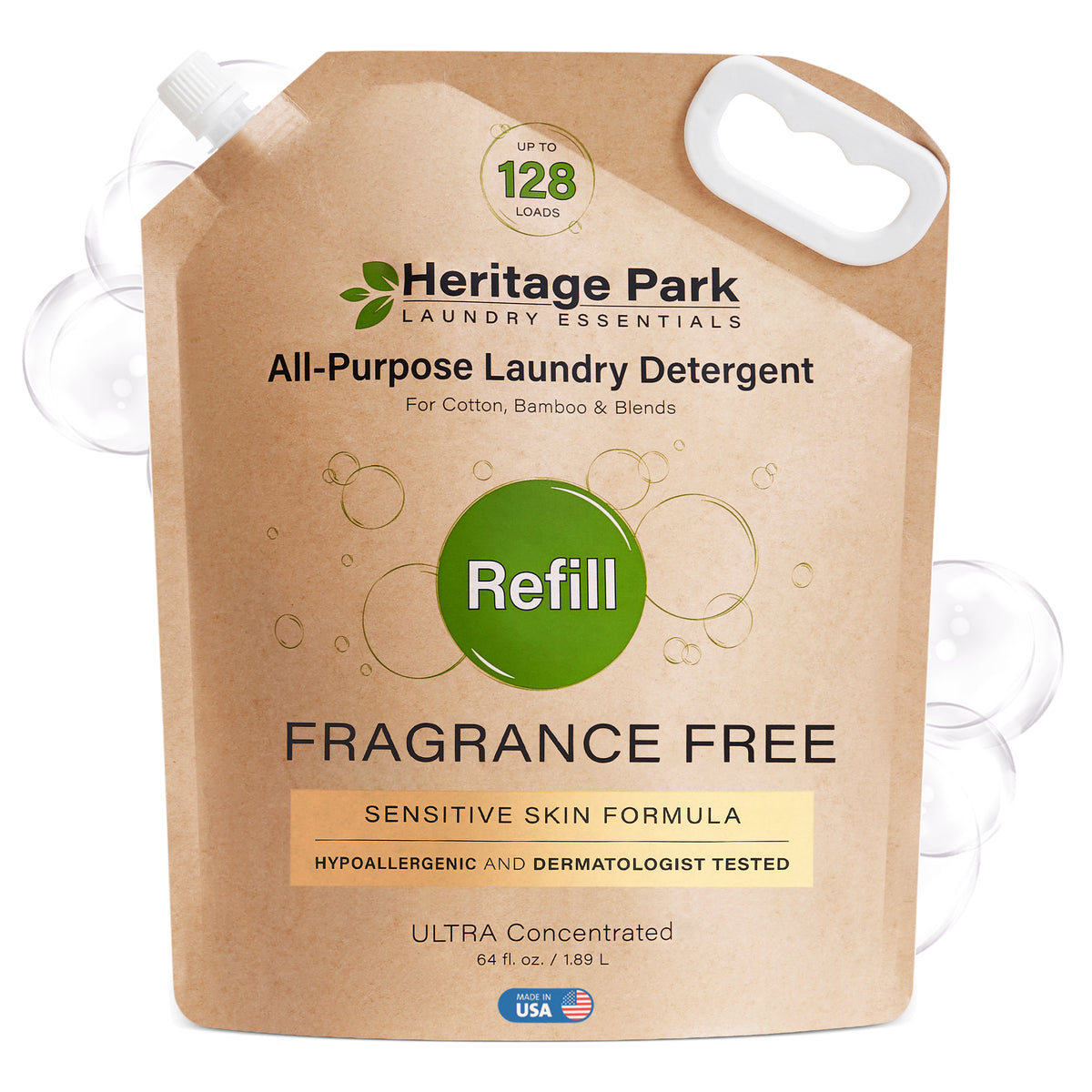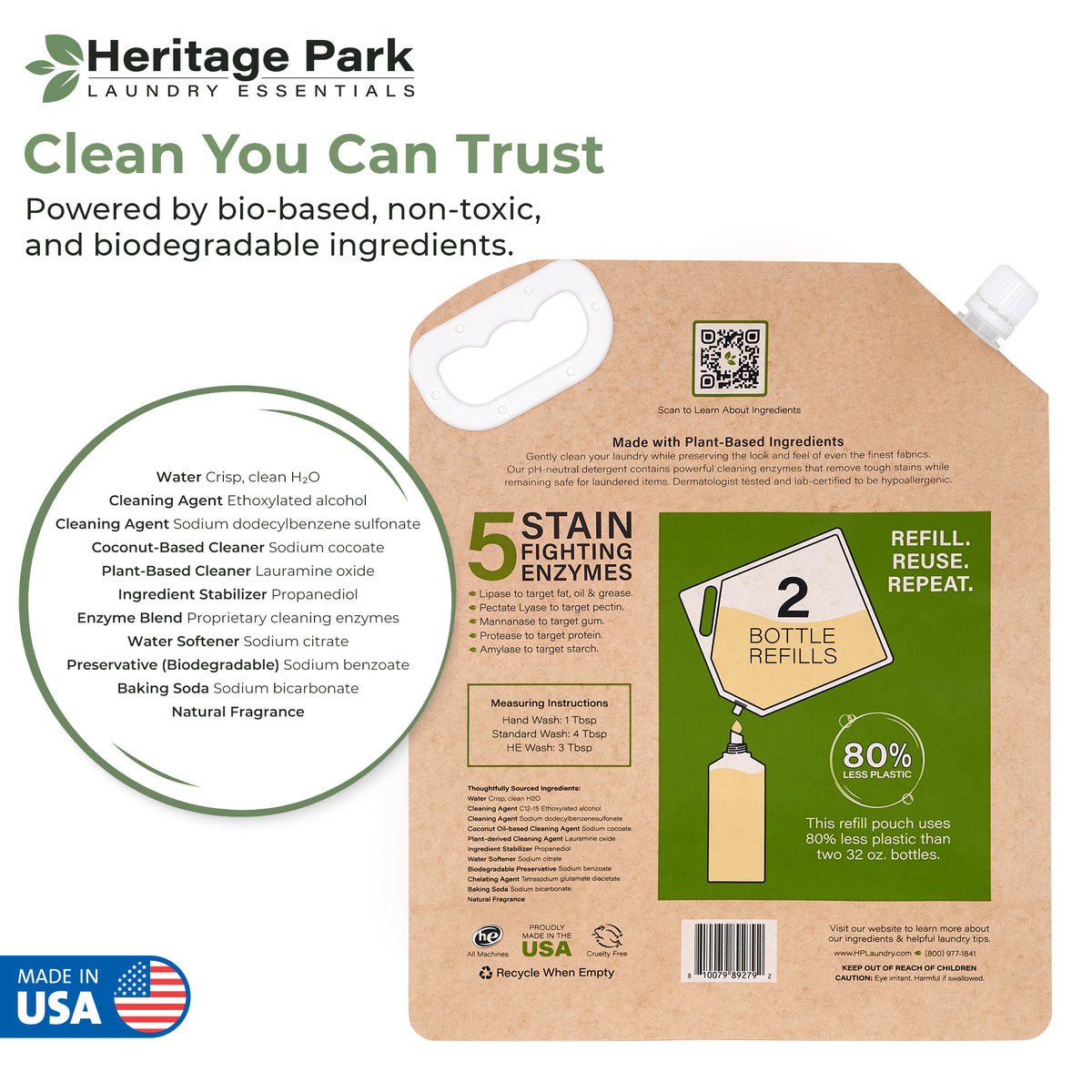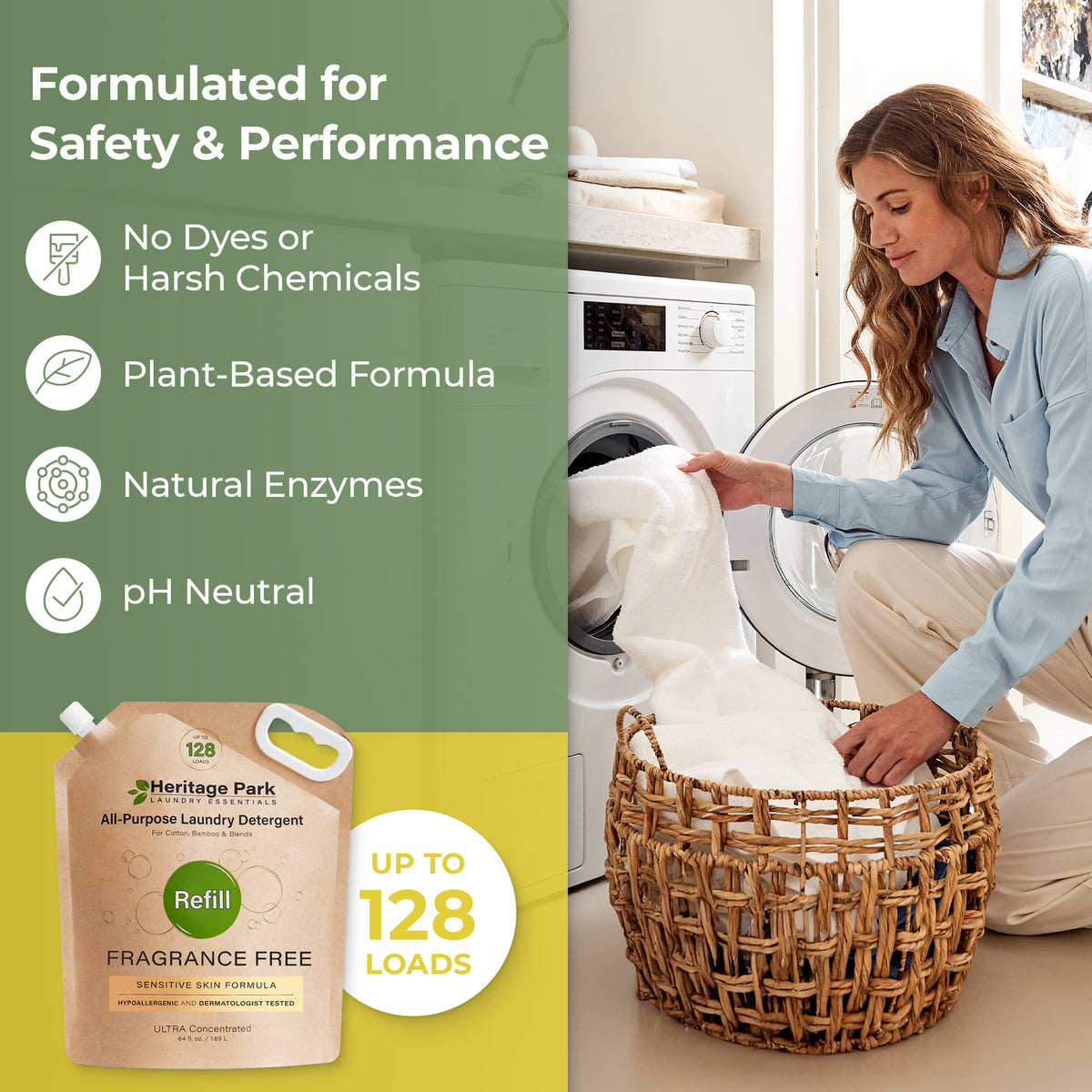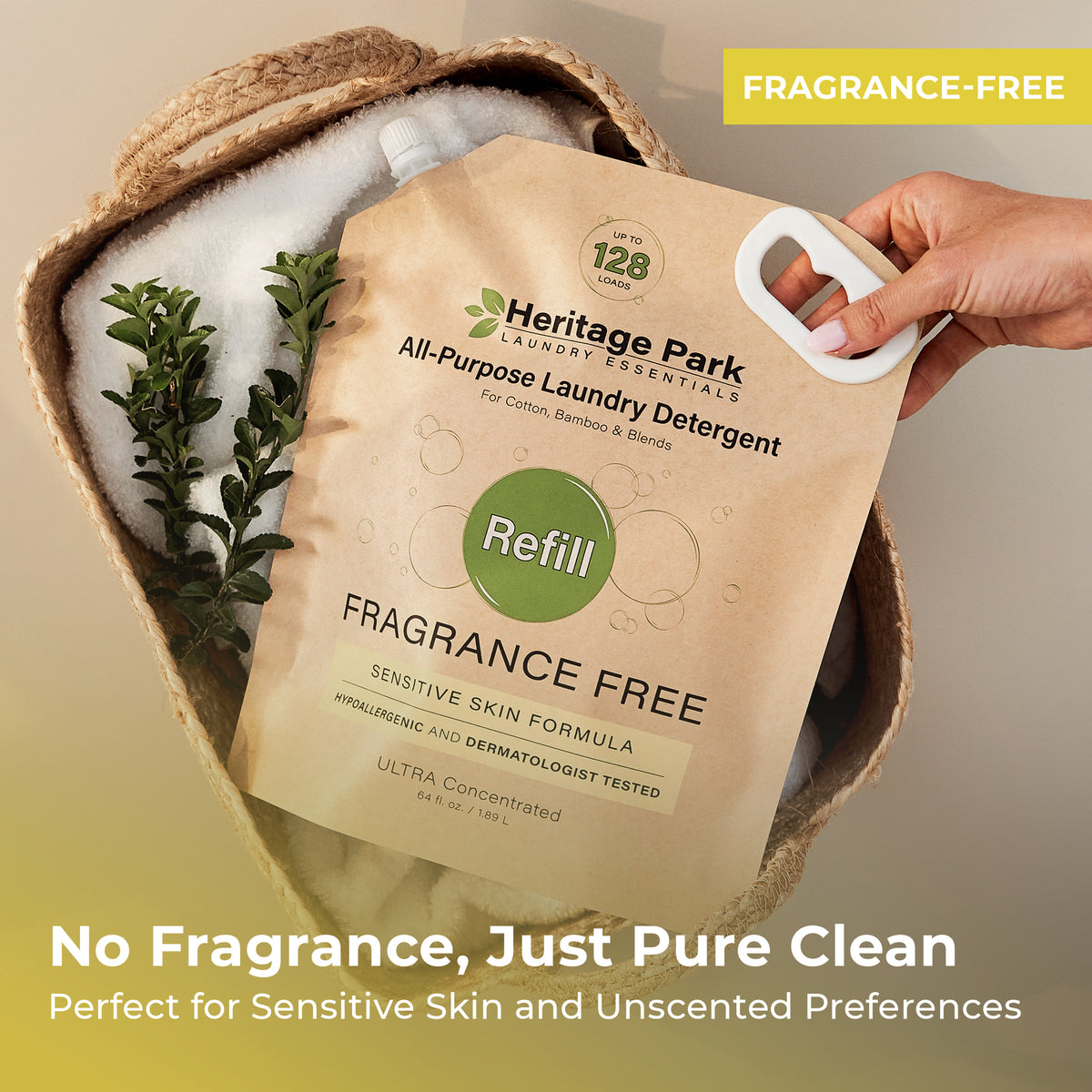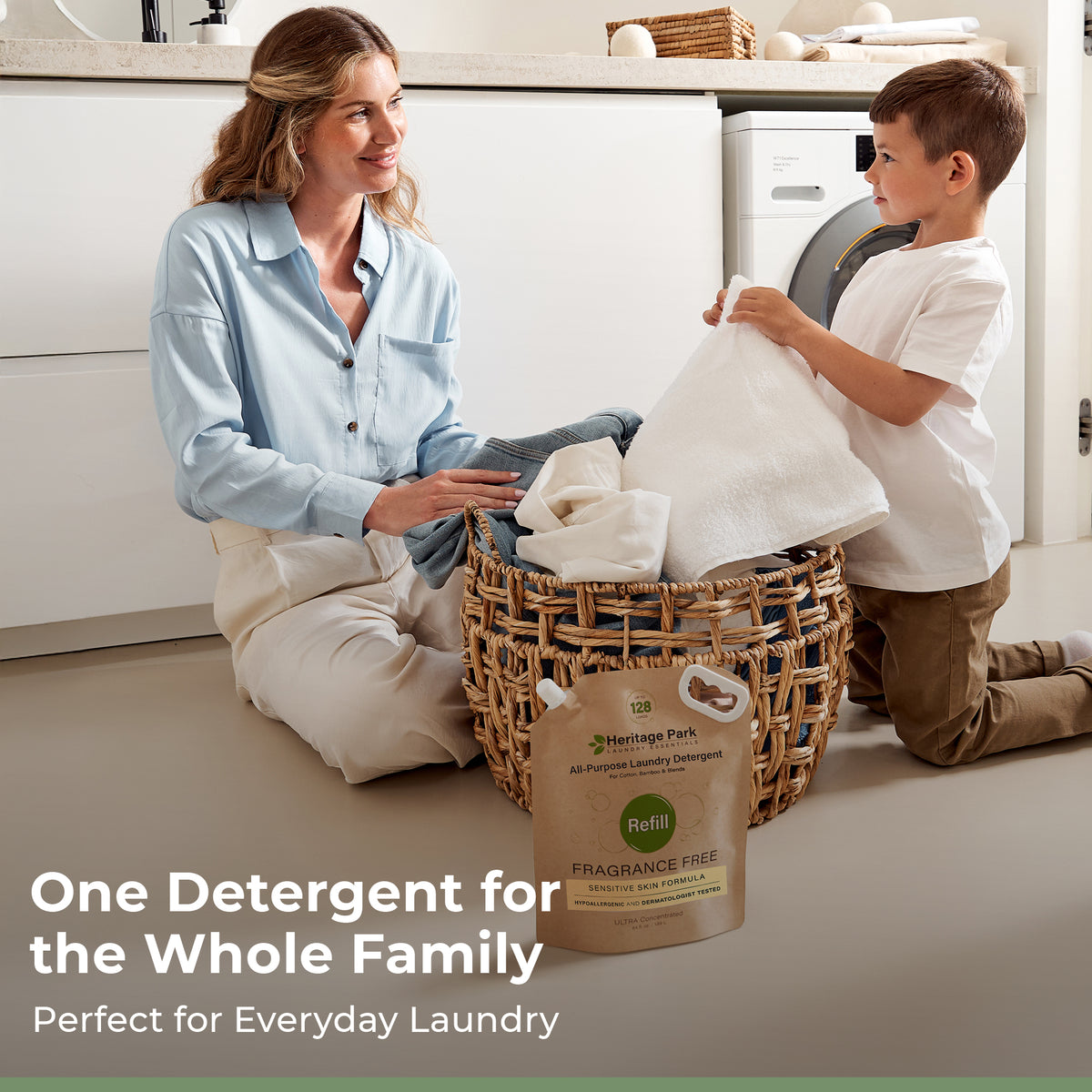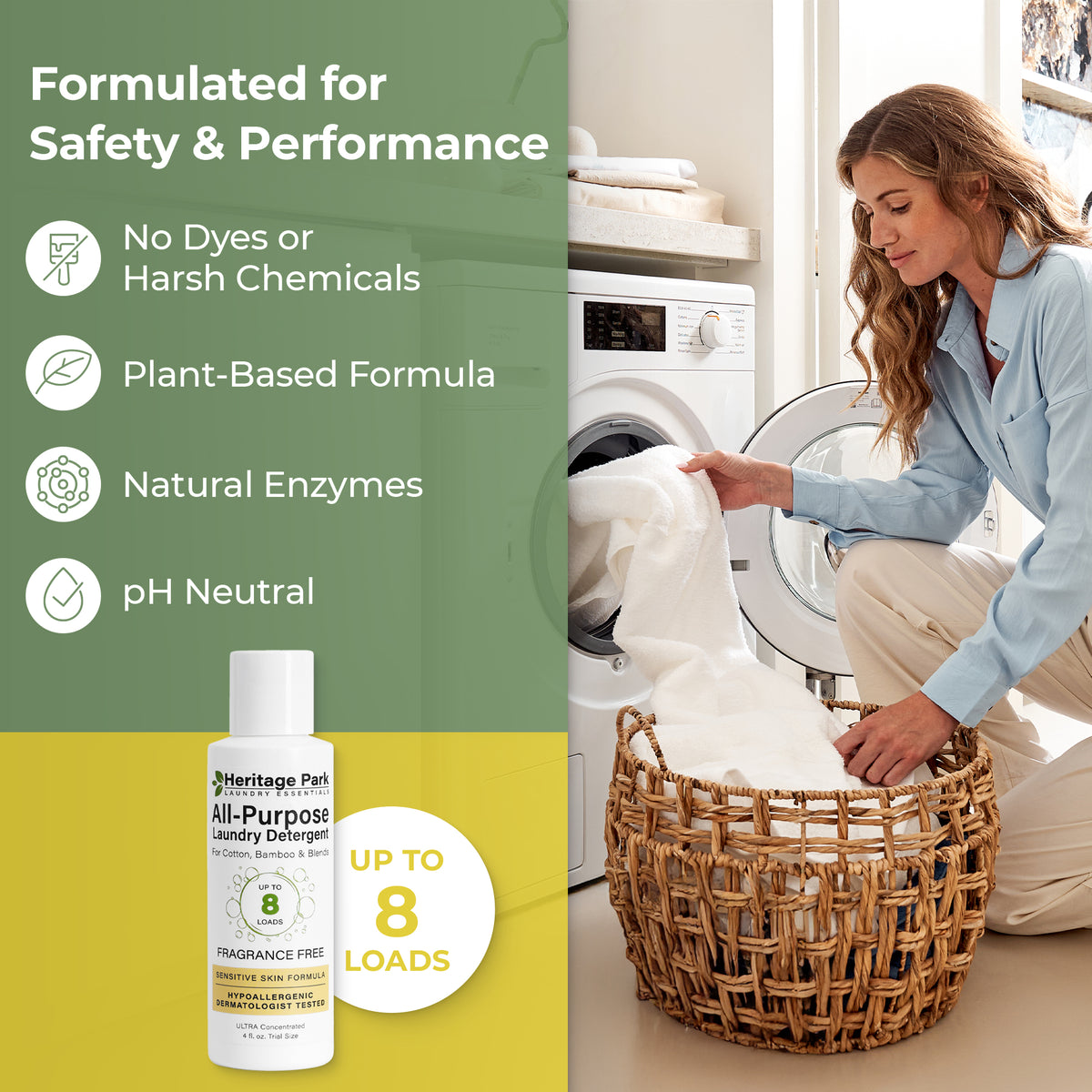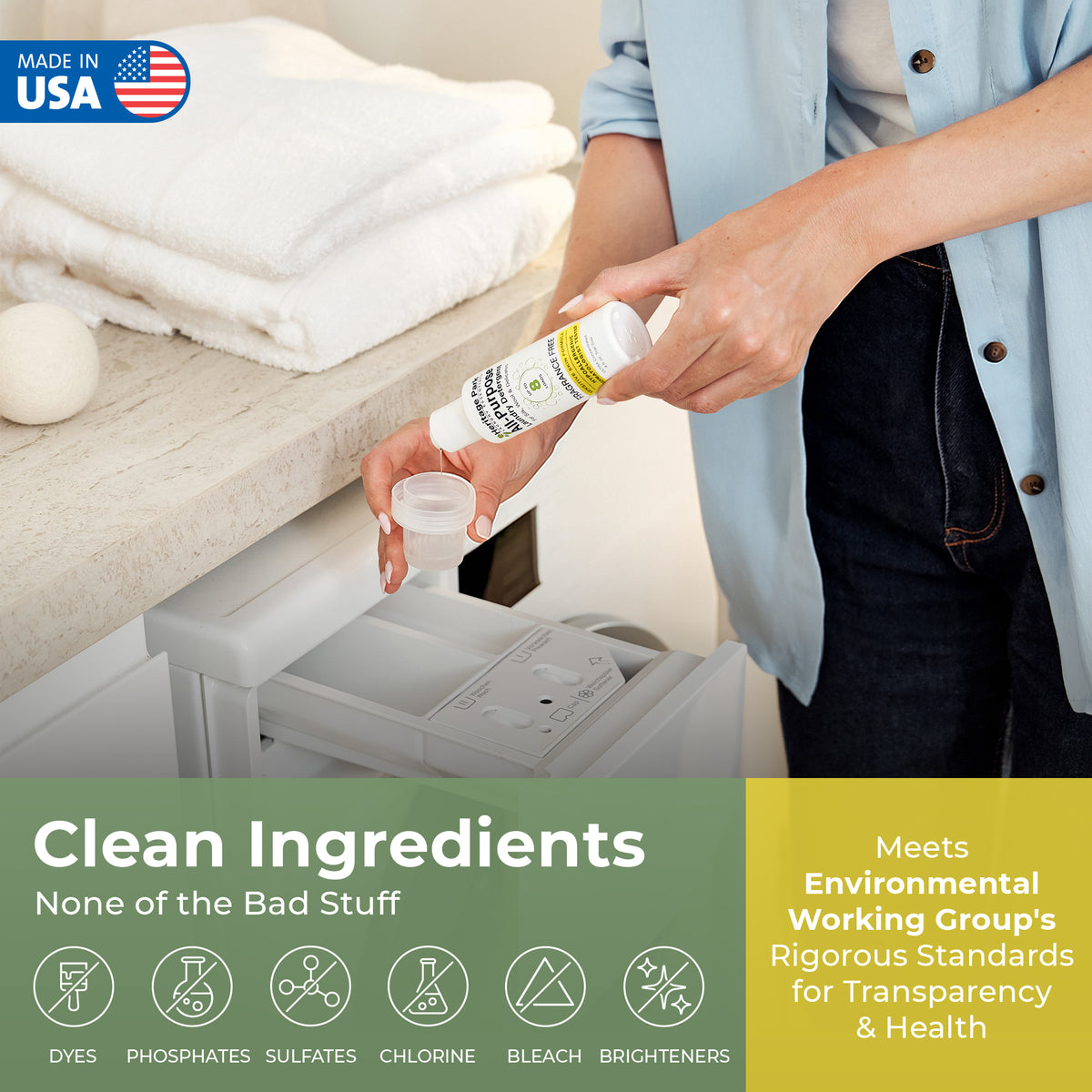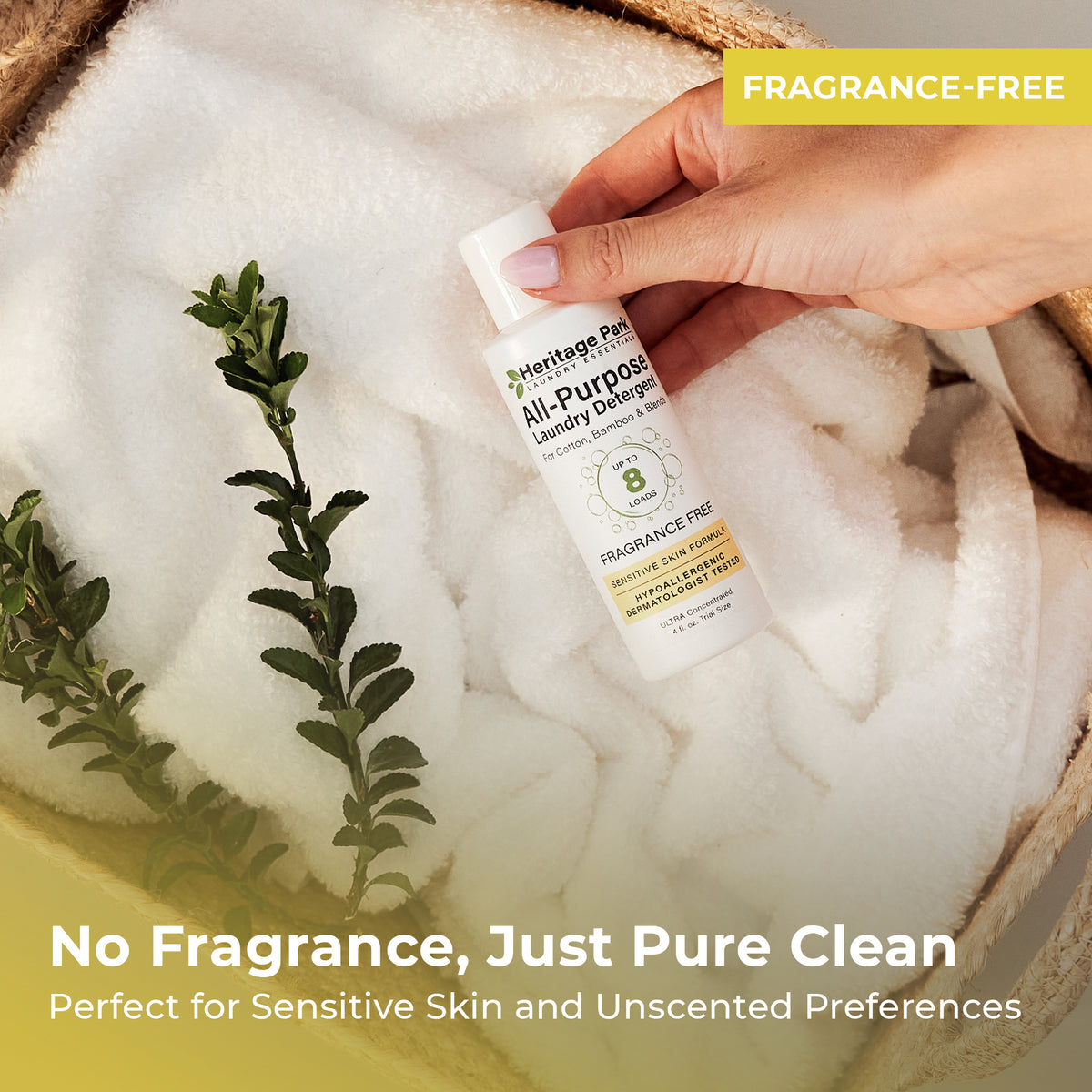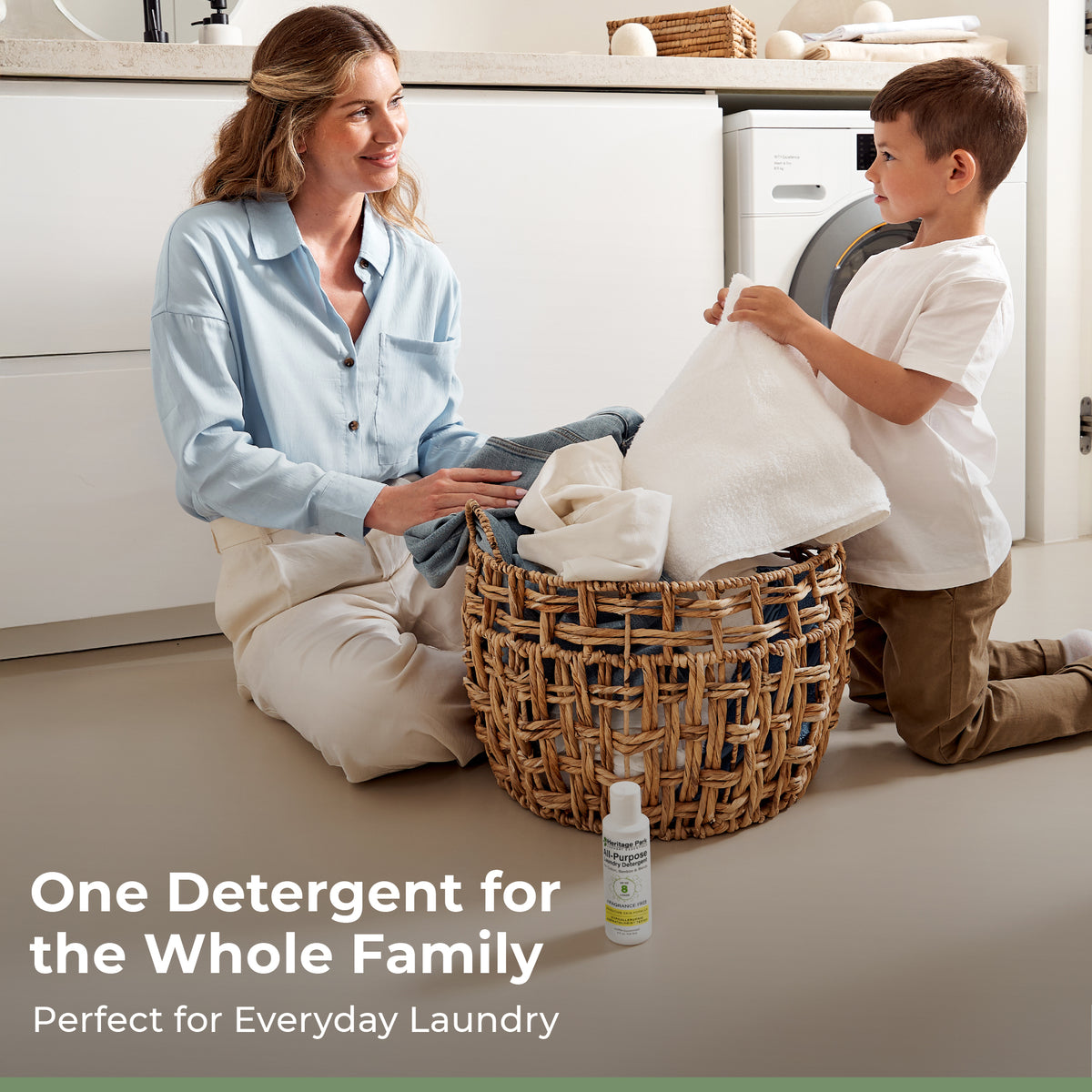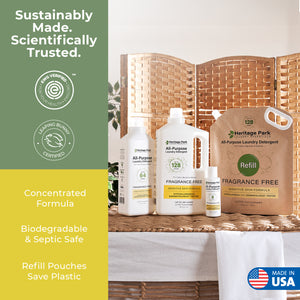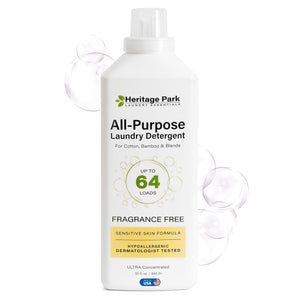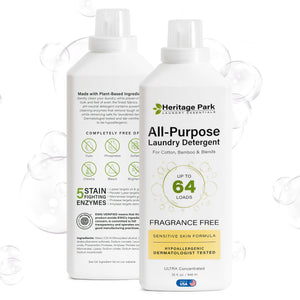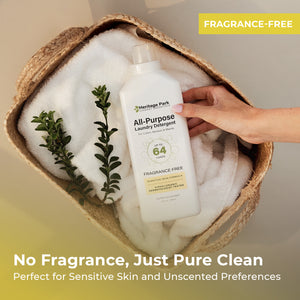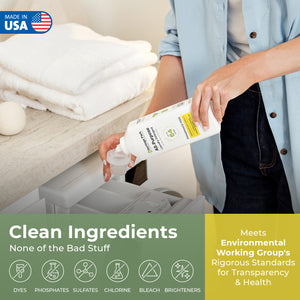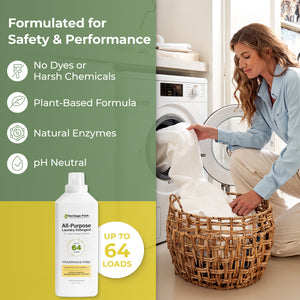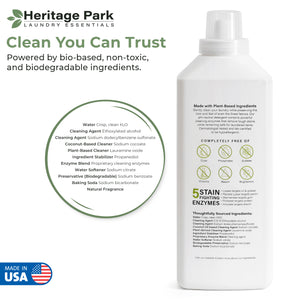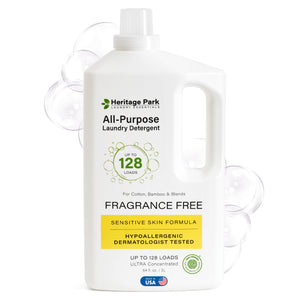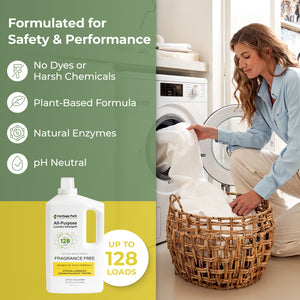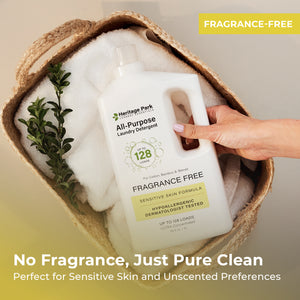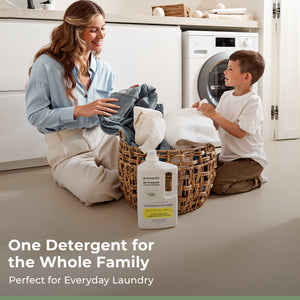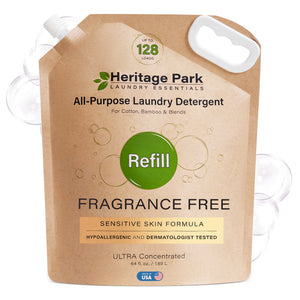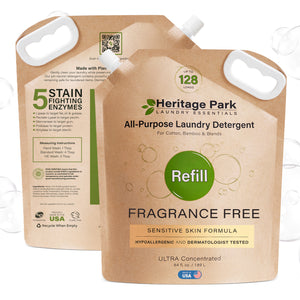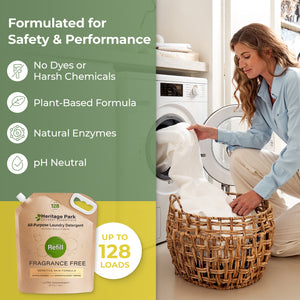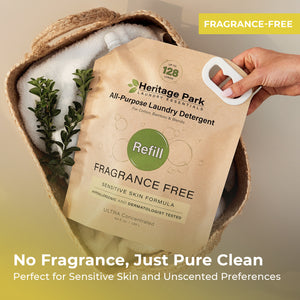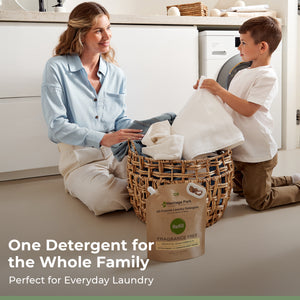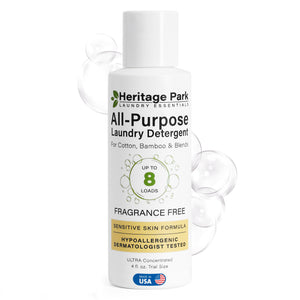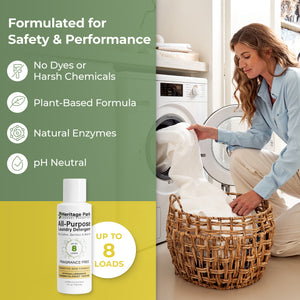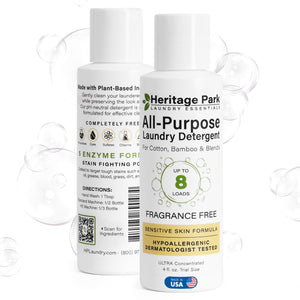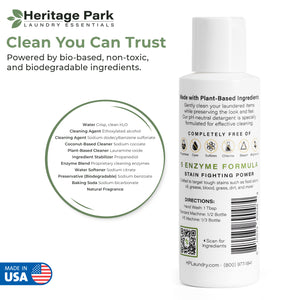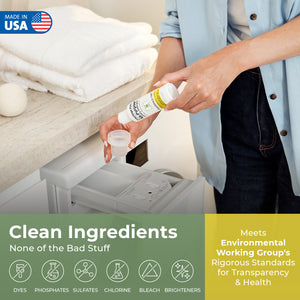Take it from us, staying clean can be a dirty business. And today at Heritage Park, we're definitely going to be giving you the ick with an up-close look at something nobody wants to think about: dust mites. So, so nasty! But also, very necessary to discuss. Dust mites are tiny, invisible insects that are one of the most common sources of allergies, skin irritation, and even asthma attacks. However unpleasant dust mites are to think about, knowing how to banish them is a big part of keeping your family healthy. And there's a lot you can do – including washing with Heritage Park All-Purpose Hypoallergenic Detergent – to control these tiny pests and minimize the damage they cause.

Inside this Article:
What are Dust Mites?
Dust mites are microscopic creatures, measuring only about 0.3 millimeters in length, that thrive in our homes. These tiny arachnids (related to spiders, cue the scary music) feed on dead skin cells shed by humans and pets, making our living spaces their ideal habitat. They flourish in warm, humid environments, which is why they're often found in bedding, upholstered furniture, and carpets.
While dust mites don't bite humans, their waste (mite droppings) and decomposing shells (we warned you!) become a significant component of household dust and are potent allergens for many people. When dust mites are inhaled or come in contact with skin, they can trigger a host of unpleasant allergic symptoms like sneezing, runny nose, allergic rhinitis, watery eyes and itchy skin and, in severe cases, asthma attacks and other breathing difficulties.
Because dust mites are not visible to the naked eye, even a seemingly clean home could be harboring these microscopic pests. Dust mites thrive in environments with humidity levels between 70-80% and temperatures between 68-77°F (20-25°C), conditions commonly found in many homes, particularly in bedrooms where bedding and body heat make attractive dust mite habitats.
Where Do Dust Mites Live in Your Home?
The best way to effectively combat dust mites is to regularly launder the washable items where they tend to congregate:
- Bedding: This includes sheets, pillowcases, duvet covers, comforters, blankets, bed skirts, and mattress pads. These items come into direct contact with our skin and collect dead skin cells, making them prime real estate for dust mites. A typical mattress can house millions of dust mites, making your bed a real hotspot for allergens. dust mites.
- Pillows: Regular pillows, down pillows, and decorative throw pillows all need attention. Pillows are close to our faces during sleep, making them a significant source of allergen exposure if not properly maintained.
- Soft Furnishings: Throw blankets, sofa cushion covers, and slipcovers can harbor dust mites. These items often go longer without washing, allowing dust mite populations to grow.
- Pet Items: Pet beds, blankets, and washable toys should be cleaned regularly. Our furry friends shed skin cells too, providing food for dust mites.
- Clothing: Rarely worn clothes and seasonal items in storage can accumulate dust mites over time. Pay special attention to items stored in closets or drawers for extended periods.
- Bathroom Linens: Wash towels, washcloths, and bath mats regularly for hygiene and to prevent mold build-up. Store clean bathroom linens in a cool, dry space, preferably a linen closet that closes. If they’ve been in storage for a while, and dust has accumulated, wash before using.
- Children's Items: Stuffed animals, soft toys, fabric books, and dress-up clothes are often overlooked but can be significant sources of dust mites and allergies among the little ones.
- Window Treatments: Washable curtains and fabric blinds collect dust and provide a home for dust mites. Launder these quarterly.
- Kitchen Items: Dish towels, fabric placemats, and cloth napkins should be washed frequently, not just for general hygiene but also to control dust mites.
- Reusable fabric shopping bags, backpacks, and car seat covers can all harbor dust mites and should be included in your washing rotation according to cleaning guidelines.
The Best Detergent for Washing Away Dust Mites
When it comes to battling dust mites, Heritage Park All-Purpose Laundry Detergent, Fragrance-Free/Hypoallergenic, is your best ally. It is a pH-neutral, plant-based formula that is fragrance-free and lab-certified hypoallergenic; that means it is gentle on fabric and skin, making it ideal for anyone with sensitivities or allergies.
The natural ingredients contain no dyes, sulfates, phosphates, chlorine, bleach, or brighteners. Instead, Heritage Park All-Purpose Laundry Detergent contains a powerful blend of natural enzymes to effectively break down and clean tough stains. Its hypoallergenic, fragrance-free formula is gentle on fabrics and skin, making it ideal for those with sensitivities or allergies. The detergent's powerful, enzyme-based cleaning action effectively removes dust mites, their waste, and other allergens from your laundry.
Use Heritage Park All-Purpose Detergent on cotton, linen, synthetics, bamboo, rayon, modal and blends. It works in regular and HE machines and in any temperature. For protein-based fabrics like silk and wool, use enzyme-free Heritage Park Silk and Wool Detergent.
An Effective Laundry Battle Plan to Bust Dust Mites
Establishing a regular and effective laundry routine is crucial in the ongoing battle against dust mites. By using Heritage Park All-Purpose Hypoallergenic Detergent, you're not just cleaning your items, but also ensuring that you're not introducing additional irritants that could exacerbate allergy and skin symptoms. Below is a sample cleaning schedule that will help you stay consistent in the battle against dust mites.
Care Note:Hot water (at least 130°F) is best for killing dust mites. If you can't wash in hot water due to fabric care instructions, use the highest temperature allowed and rely on Heritage Park's enzyme-based formula to break down dust mites and other allergens.
Cleaning Schedule to Eliminate Dust Mites
|
Item |
How to Eliminate Dust Mites |
|
Sheets and pillowcases |
Wash weekly. Dry items on high heat if possible, as this can also help kill dust mites. (Note: silk sheets are naturally resistant to dust mites. Wash them in cool water, in a gentle cycle, with a detergent made for silk, and hang dry). |
|
Duvet covers and dust ruffles |
Wash monthly, see above. |
|
Pillows, blankets, duvets, throw pillow inserts/covers |
Wash these quarterly following care guidelines. These bulky items should be washed in a front-loading machine, preferably commercial size in a laundromat. NOTE: Anything with down or feathers should be washed in an enzyme-free detergent. Drying time will also take longer for these, so be patient. Also, consider using allergy-proof covers on pillows, mattress, and box spring to reduce dust mite activity between washes. |
|
Towels, washcloths, and bath mats |
Launder these in warm water every 3 to 4 days. The enzymes in Heritage-Park detergent will break down dirt, odors, and any dust that has accumulated. Dry thoroughly (damp towels are a breeding ground for mold). Wash and dry any towels before storing and keep them in a cool, dry place. |
|
Clothing |
Wash according to care labels, using warm or hot water when possible. Heritage Park's concentrated formula is effective even in cold water for delicate items. Pay special attention to clothes stored for long periods, shaking them out and washing before wear. Store off-season clothing in dust-proof bags if possible. |
|
Children’s items (stuffed animals, toys) |
Wash monthly in warm water. The hypoallergenic formula is safe for items that come into close contact with children's sensitive skin. For non-washable items, consider freezing them for 24 hours to kill dust mites, then thoroughly vacuuming. |
|
Window treatments and upholstery |
Wash curtains and fabric blinds every 3-6 months in warm water. The gentle yet effective formula will clean without damaging delicate fabrics. Vacuum furniture regularly with a hand-held attachment; wash removable slipcovers every 3 months, more frequently if you have pets. Launder throw blankets once a month. |
|
Kitchen linens |
Wash in hot water after each use. The powerful cleaning enzymes in Heritage Park detergent will tackle both dust mites and food-related stains. Regular washing of these items is crucial not just for dust mite control but for overall kitchen hygiene. |
Beyond the Laundry Room: More Tips for Controlling Dust Mites
Along with staying on schedule with laundry and wash, there are other things you can do to reduce house dust mites:
- Control Humidity: Keep indoor relative humidity levels between 30-50%. Use a dehumidifier, if necessary, especially in damp areas like basements.
- Use Dust-Proof Covers: Encase mattresses, box springs, and pillows in dust-proof or allergen-impermeable covers.
- Regular Vacuuming: Vacuum carpets and upholstered furniture at least twice a week using a vacuum cleaner with a HEPA filter. Steam clean carpets every few months.
- Replace Carpeting: Consider replacing wall-to-wall carpeting with hard flooring, which is easier to keep dust-free and won’t attract such a robust dust mite population.
- Air Purifiers: Use a high-quality air purifier with a HEPA filter to remove airborne dust mite particles and improve indoor air quality.
- Declutter: Reduce the number of items that can collect dust in your home, especially in bedrooms.
- Groom Pets: Regularly groom pets outside to reduce the amount of pet dander in your home.
- Dust items in your home with a damp cloth from top to bottom (to avoid contaminating already clean surfaces).
Fighting dust mites is an ongoing process, but with the right tools and knowledge, it's a battle you can win. By implementing a comprehensive cleaning routine that includes regular washing with Heritage Park All-Purpose Hypoallergenic Detergent, you're taking a significant step towards creating a healthier, allergen-reduced home environment.


